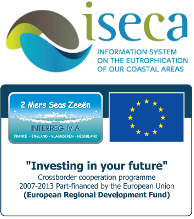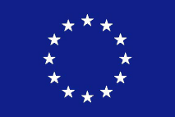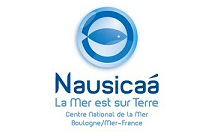→ GO TO ISECA deliverables on Modelling
"Nutrients originate from wastewater, farming, industries and atmospheric deposition and find their way to the coastal waters and sea through river systems. Eutrophication or a high amount of nutrients in the water column can cause strong algal blooms. Such blooms are annoying for beach recreation and can, depending on the temperature of the water and other factors, cause oxygen depletion. Reduced oxygen availablity causes stress on the ecosystem and even high fish mortality."
Eutrophication has the growing attention of the regional and international community, and has been studied extensively during the past decades. The quality of marine waters is monitored continuously by means of water samples (“in-situ data”) and satellite observation. Nevertheless, the occurrence of bloom events is difficult to predict, and more understanding is needed of the effectiveness of different management strategies. Scientific models are valuable tools in addition to field and satellite data because they can be used to analyze the causes and consequences of eutrophication and predict bloom events. Integrated models are the first choice, because eutrophication is the result of complex interactions between human activities, hydrodynamics, and ecological processes.
The purpose of the Web Application Server (WAS) on the ISECA portal is to demonstrate how model simulations can be combined with field measurements and Earth Observation data online in a platform for monitoring and analysis of coastal eutrophication in the English Channel and Southern North Sea. In addition researchers will be given access to a generic library of reusable model components, which makes the construction of models easier.
The WAS will enable you to select and compare the impact of different scenarios and management options on key water quality indicators and identify problem areas following the OSPAR recommendations (www.ospar.org). A first version of the WAS prototype will combine in-situ data with earth observation data. Earth observation data will be corrected to local observation by means of modelling the relationship between the atmosferic conditions and reflectance of the water.
The access to the WAS will be restricted to registered users in order to respect the data rights and identify the potential end users.

For more information on the modelling of the impact of atmospheric conditions on eutrophication please contact This email address is being protected from spambots. You need JavaScript enabled to view it. of the School of Computing and Mathematical Sciences of Greenwich University
For more information on the modelling reflectance of the water surface please contact This email address is being protected from spambots. You need JavaScript enabled to view it. of the Earth Observation Unit of the Flemish Institute for Technological Research VITO.
For more information on the WAS application and model library please contact This email address is being protected from spambots. You need JavaScript enabled to view it. of the Unit Environmental Modelling of the Flemish Institute for Technological Research VITO.













